Today’s recipe is bibimbap, a super-popular Korean dish you might have heard about already! It’s made of a bowl of rice, sautéed and seasoned vegetables (namul: 나물), a bit of hot pepper paste (gochujang: 고추장), and usually a bit of seasoned raw beef, too (yukhoe: 육회).
Bibim (비빔) translates as “mixed,” and bap (밥) means “cooked rice,” so bibimbap literally means “mixed rice.” Before eating it you’re supposed to mix everything all together.
There are many variations on this dish, from simple to elaborate, and this recipe I’m showing you today is for one you could consider “classic” bibimbap. If you ordered bibimbap in a Korean restaurant, you would probably get something like this dish, with regional variations. I’m also going to show you bibimbap prepared and served in a heated stone or earthenware bowl called dolsot-bibimbap (돌솥비빔밥). “Dolsot” means “stone pot” in Korean, and this version is well-known for the way the bowl makes a layer of crispy, crackling rice on the bottom of the bibimbap.
Even though we mix up bibimbap before we eat it, each ingredient needs to be prepared with care and individuality, bringing out their unique flavors, textures and colors so they come together beautifully in the bowl and deliciously in your mouth. The different ingredients aren’t random, they’re chosen because they balance, harmonize, and offset each other.
This recipe isn’t quick and easy, it takes some time to make. But if you’re really in a rush you can make a great bibimbap with the soybean sprouts, spinach, and carrot (or red bell pepper, or both), and gochujang, toasted sesame oil, and an egg— those items are unskippable!
I’m going to share some more bibimbap recipes on my website in the future, and you’ll see how many different variations there are. This version is a little different than the version in my cookbook, because I make a quick and simple soup with the bean sprouts. When I started my YouTube channel, bibimbap was one of the first recipes I made, because it’s such an essential dish in Korean cuisine. So I’m happy to remake the video now in HD with much better editing and instruction. I’ve been building up to this video by remaking videos for the ingredients, too. I remade yukhoe, and sigeumchi-namul, and my yukagaejang video has a lot of detail about preparing the mountain vegetable fernbrake.
So if you’ve been following my videos, you’re now ready to be a bibimbap master! Ready? Let’s start!
Ingredients
Serves 4
- 5 cups cooked short-grain rice
- 12 ounces soy bean sprouts, washed and drained
- 8 ounces of spinach blanched and washed with the excess water squeezed out by hand
- 1 large carrot
- 1 large red bell pepper
- 1 large zucchini
- 1 English cucumber
- 3 to 4 green onions, chopped
- ½ pound fresh lean cut of beef (fillet mignon, flank steak)
- 4 ounces fernbrake (gosari), fresh or soaked from ½ ounce dried gosari (details below)
- 1 ounce dried bellflower roots (doraji), soaked in cold water for 18 to 24 hours.
- 4 eggs
- kosher salt
- vegetable oil
- toasted sesame oil
- toasted sesame seeds
- garlic
- soy sauce
- honey (or sugar)
- Korean hot pepper paste (gochujang)
How to prepare dried fernbrake (gosari) for use
If you have presoaked or fresh fernbrake you can use it straight away, but if you have dried fernbrake you’ll need to get it ready to eat. It’s fast if you have a pressure cooker, but if you don’t it will take some time.
With a pressure cooker:
- Wash ½ ounce of dried gosari and boil it with 5 cups of water in a pressure cooker for 30 minutes.
- Drain and rinse in cold water a couple of times.
- Drain. It should make 4 ounces.
In a pot on the stove:
- In a large saucepan add ½ ounce of dried gosari to 7 cups of water. Bring to a boil over medium-high heat and boil for 30 minutes. Cover and let stand until cool, about 2 to 3 hours.
- Rinse the fernbrake a couple of times, drain and put in a bowl. Cover with fresh cold water and let soak for at least 8 hours or overnight in a cool place, changing the water 2 or 3 times during the soaking.
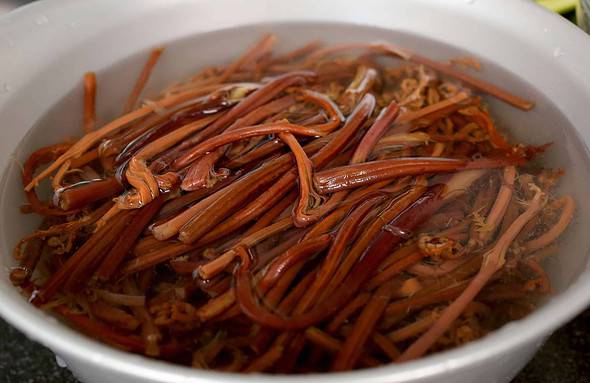
- Taste the gosari: It should be soft. If it’s tough, boil it again in a fresh pot of water for about 20 minutes and then let it sit, covered, until soft.
- Drain. It should make 4 ounces.
Make rice
If you have a usual method for making rice or have a rice cooker, go ahead and make 5 cups of rice like you usually do. But here’s how I do it on a pot on the stove. 2 cups of dried rice makes about 5 cups of cooked rice.
- Rinse 2 cups of rice in cold water and scrub the wet rice with your hand. Rinse and drain until the drained water is pretty clear.
- Put the rice in a heavy-bottomed pot. Add 2 cups of water, cover, and soak for 30 minutes.
- Cook over medium high heat for 7 to 8 minutes until the surface is covered with abundant bubbles that are spluttering noisily and look like they’re about to overflow the pot. Turn the rice over a few times with a spoon and cover the pot again.
- Turn the heat to very low and simmer for another 10 minutes until the rice is fully cooked and fluffy. Remove from the heat.
- Fluff the rice with a spoon to release excess steam. Let the rice stand, covered, at room temperature to keep it warm.
Prepare and cook the ingredients for bibimbap
I like to get a big platter and then put each vegetable on it as they’re ready. I think it looks really pretty, but you don’t have to do this. When all vegetables are prepared and ready to use, the platter looks pretty delicious!
Soybean sprouts:
- Put the soy bean sprouts in a pot and add 4 cups water and 2 or 3 teaspoons salt. Cover and cook for 20 minutes over medium high heat. Take out the sprouts with tongs and put them into a bowl, leaving about ½ cup of sprouts in the pot with the water you used to boil them. This is the soup to serve with bibimbap later.

- In a bowl, mix the sprouts by hand with ½ teaspoons salt, 1 teaspoon minced garlic, and 2 teaspoons toasted sesame oil. Put them on the large platter.
Spinach:
- Cut up the blanched spinach a few times and put it in a bowl. Mix by hand with 1 teaspoon garlic, 1 teaspoon toasted sesame oil, ½ teaspoon kosher salt, and 1 teaspoon sesame seeds. Cover and put it next to the soy bean sprouts on the platter.
Other fresh vegetables:
- Cut the carrot into matchsticks, put them in a bowl, and mix with a pinch of salt. Let stand for 5 to 10 minutes until sweating.

- Cut the red bell pepper into halves, deseed, and slice into strips. Put them in a bowl.
- Cut the zucchini into matchsticks and mix with ½ teaspoon kosher salt.
- Cut the cucumber into halves lengthwise and slice thinly crosswise. Mix with ¼ teaspoon kosher salt.
Beef:
- Cut the beef into matchsticks and put them in a bowl.
- Mix with 1 tablespoon minced garlic, 1 tablespoon soy sauce, 1 tablespoon honey, 2 teaspoons toasted sesame oil, and 1 teaspoon sesame seeds with a spoon.

- Cover and keep in the fridge until ready to use.
Mountain vegetables:
- Cut the fernbrake (gosari) a few times into bite size pieces. Set aside.
- Put the bellflower roots (doraji) in a large bowl. Add 1 or 2 tablespoons salt. Rub for a minute to wilt slightly and release some of the bitterness. Rinse them in cold water a couple of times and drain. If you find some roots are too thick, split them lengthwise. Set aside.
Let’s cook!
- Heat up a pan over medium high heat. Squeeze out excess water from the carrot. Add a few drops of cooking oil to the pan and sauté the carrot for 1 minute. Put it on the platter next to the soy bean sprouts and spinach. Clean the pan with wet paper towel or wash it.
- Heat a few drops of cooking oil in the pan and squeeze out the excess water from the cucumber. Sauté with ½ teaspoon minced garlic and a few drops of toasted sesame oil for 30 seconds. Put it on the platter. Clean the pan.
- Heat up the pan with a few drops of cooking oil. Add the red bell pepper and sprinkle a pinch of salt over top. Sauté for 30 seconds. Put it on the platter. Clean the pan.
- Heat up the pan and squeeze out excess water from the zucchini. Add a few drops of cooking oil and sauté with 1 teaspoon minced garlic, 1 tablespoon chopped green onion, a drop of toasted sesame oil for 1 minute until slightly softened. Put it on the platter. Clean the pan.
- Heat up the pan with a few drops of cooking oil. Add the bellflower roots and sauté for 2 to 3 minutes. Lower the heat to medium so as not to brown them. Add 1 teaspoon minced garlic and a drop of toasted sesame oil. Stir for another minute until a little softened. Put it on the platter. Clean the pan.

- Heat up the pan. Add a few drops of cooking oil. Stir the gosari for 2 minutes until a little softened. Add ½ teaspoon of minced garlic, 2 teaspoons soy sauce, and 2 teaspoons sugar, and keep stirring for another minute. Put it on the platter.
Serve
Here are a couple of ways to serve: bibimbap in a regular, shallow bowl, and dolsot-bibimbap in a stone or earthenware bowl.
In a regular, shallow bowl
- Reheat the soybean sprout soup.

- Divide the cooked rice into 4 portions. Each portion will be a little more than 1 cup of rice.
- Put the rice in each of 4 bowls and arrange the vegetables and beef on the rice. Top with a raw egg yolk and gochujang. If you prefer your eggs and beef cooked, use a fried egg sunny side up and slightly pan-fry the beef before putting them on the top of rice.
- Sprinkle the bibimbap with the sesame seeds and drizzle with sesame oil to taste.
- Ladle the soup to a small bowl and sprinkle some chopped green onion over top.
- Serve right away with more hot pepper paste on the side, and maybe kimchi too.

Dolsot-bibimbap in a hot earthenware bowl (ttukbaegi) or hot stone bowl (dolsot)
- Reheat the soybean sprout soup.
- Put a few drops of toasted sesame oil in the bottom of each of 4 earthenware bowls. They should be big enough to hold 4 to 6 cups each.
- Divide the rice among the bowls. Arrange the vegetables and beef on the rice. Top each serving with a raw egg yolk and 1 tablespoon gochujang. If you prefer your eggs and beef cooked, use a fried egg sunny side up and slightly pan-fry the beef before putting them on the top of rice.
- Set each pot on a burner. Heat over medium high heat until you hear a ticking, crackling sound coming from the rice.

- Sprinkle the bibimbap with the sesame seeds, drizzle with sesame oil to taste.
- Ladle the soup to a small bowl and sprinkle some chopped green onion over top.
- Serve right away with more hot pepper paste on the side and maybe kimchi too.

Eat
Maangchi's Amazon picks for this recipe
It's always best to buy Korean items at your local Korean grocery store, but I know that's not always possible so I chose these products on Amazon that are good quality. See more about how these items were chosen.



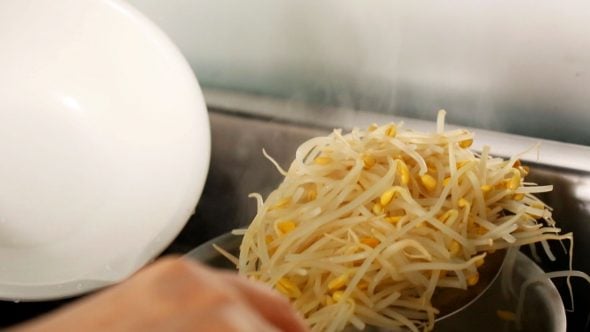
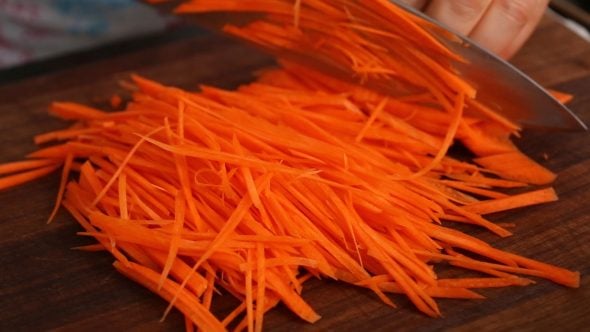
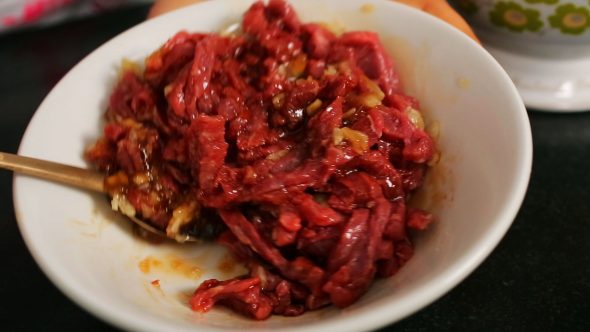
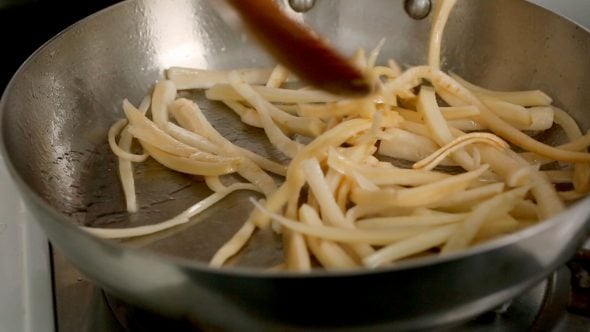
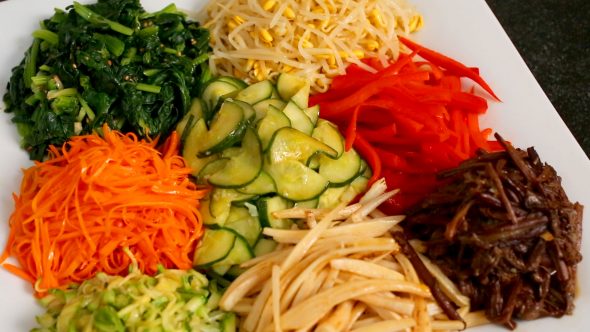
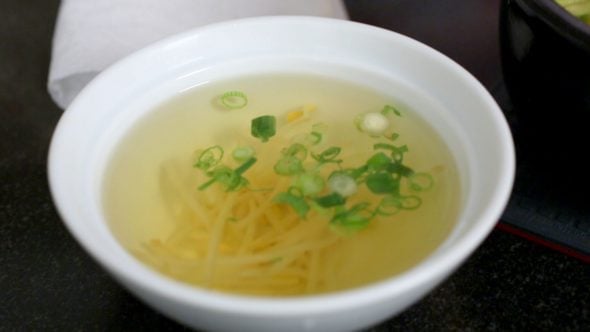
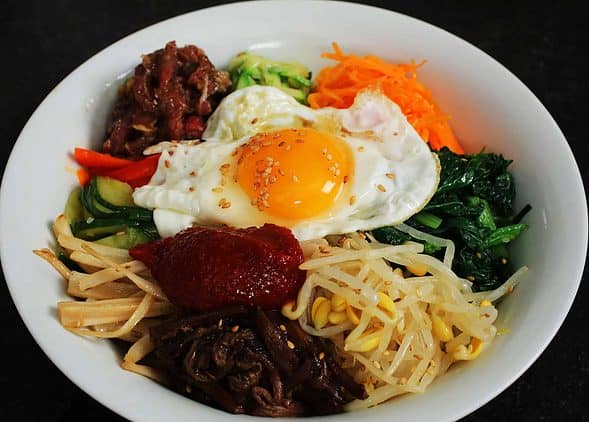

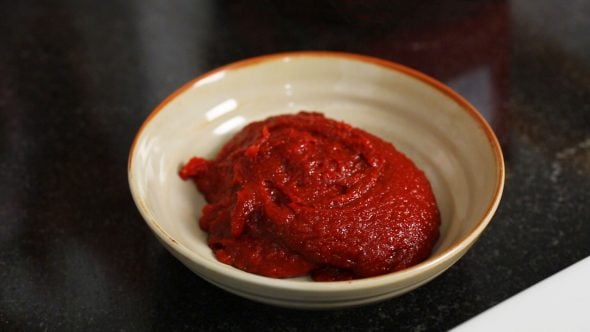
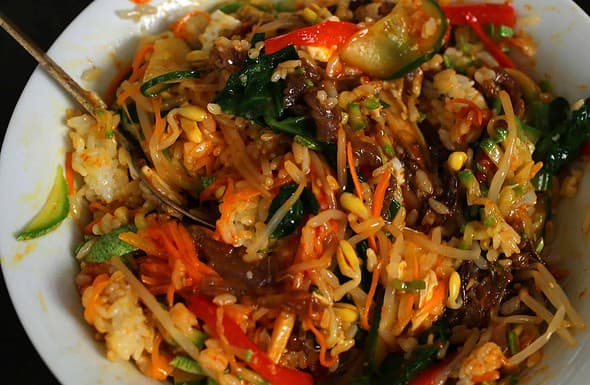






![[OTTOGI] Delicious COOKED RICE...](https://m.media-amazon.com/images/I/41zYdZ3EWJL._SL160_.jpg)


























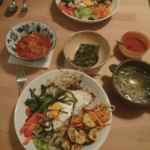
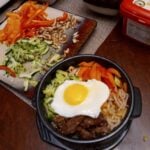
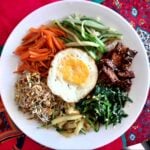
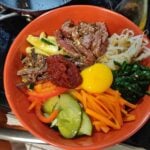
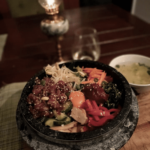
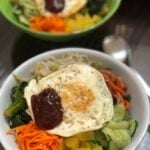
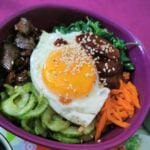
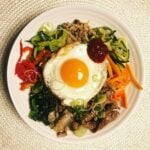
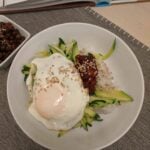
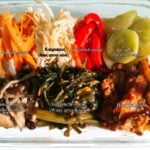
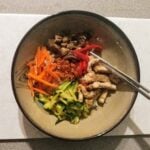
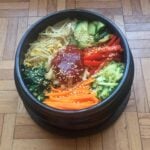
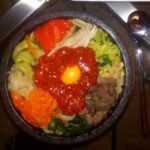
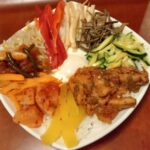

마리,
Yes, skip it if kosari is not available near you.
Check out my photos in ingredient blog. You will see what it looks like: dried or soaked.
This recipe is more like authentic style.
yes, you can mix rice with chopped kimchi and hotpeper paste to make very simple bibimbap. Don’t forget sesame oil! : )
i have a question, how do i know if the kosari is soaked and cooked when in the grocery? do i have to ask? its ok to omit kosari if i cant find it right? i cant seem to see this at the korean gorcery. but i do my bibimbap like this just without the kosari.sometimes, i add kimchi. im also from the philippines, im trying to learn to cook korean i love spicy food. sometimes, i wish to learn in korea how to make those foods.
dona
Wow, you must be a skillful cook! It sounds like you can make any korean dishes well by just following my recipes. Your family wanted to eat bibimbap for lunch and dinner? : )I agree!
hi maangchi!
im dona from philippines
i’m exploring korean culture and i’m so happy
to have found your videos. i love to cook
and can only eat korean foods at korean restaurants..
when i saw your videos i tried to make your recipe
starting with bibimbap for lunch..my family loved it
and asked me to make it for dinner..kkk…it was much better the second time around..i don’t have kosari so i just skipped it and also added shrimp(my fave)…
now, i can eat korean food at the convenience of our home while honing my cooking skills…thanks to you..looking forward to more of your videos and recipes,,,^^
Hi, Sunjung,
You must be very interested in cooking even though you are very young! Thank you for your nice comment!
I’m a middle school student in Korea.
It’s sooooooo funny. ^^
한국에 사는 중학생인데요!!!
재밌게 즐겨보는 UCC중의 하나예요,,,
앞으로도 맛있는 비디오 많이 올려주세요^^
Hello thanks a lot for sharing =)
I’m from Burma and love korean food =D I’ve never tried korean food in my country. Now I’m in Singapore and have tried twice korean food and BiBimBap was chosen both times =D I like it. Here in Singapore, we don’t really have many options to choose when we enter into a korean restaurant, only around 6 options and all of them r very simple [they don’t even sell Black Bean Noodle -_-||] Now, I can try by myself by checking ur videos =D
Thanks again
Hi Maangchi,
I’m so glad that I found your website. I’ve been trying to make Korean food for quite a long time but never got to the right taste. Thank you for your wonderful work. I really love the way you taste your food when it’s done “very delicious” :D. I hope I could be able to make it as good as yours.
Take care!
DTT
Hi, Jini from Chile!
Thank you for your compliment.
Oh jing uh bokkeum is your request? I alredy posted fresh squid dish as “Stir fried squid”. Check it out. Dried squid side dish is already in the list of my upcoming cooking videos, too.
안녕하세요 Maangchi님
I’m a girl from CHILE! (so far, huh?)
Well.. i’d have to say that 비빔밥 is MY FAVORITE korean dish :D~~ and i was trying to find a recipe to make it… and i foud your blog!
YOU ARE AMAZING! your videos are the best, you’re a very good cooking teacher! ;D
Thank you so much! :D
i’ll try to make every dish you explained! :D
Could you please teach us how to make ojingeo bokkeum? it’s so delicious!! T_T
Anonymous,
Do u like to learn how to make hot pepper paste(go chu jang)? : )
I used to make it when i lived in Korea, but not anymore because it’s very time consuming work!
But I will think about making the video later.
how to make the hot pepper paste?
Anonymous,
Yes, you can make it at home.
First spread some sesame oil in dolsot and place some cooked rice evenly over the bottom of the dolsot. Then place all colorful ingredients on top of the rice.
Cover the dolsot and cook over medium-high heat until you hear rice crackling. Then crack an egg on top just before serving. Thank you!
Maangchi,
Great website and I really enjoy your recipes and videos. Is it possible to make dolsot bibimbap at home?
Karen,
Yes, I think you have to soak it with more hot water and longer period than you did.
I like kosari, too. Delicious.
Hi Maangchi!
I used your recipe to make bibimbap the other night and it turned out spicy and delicious! :o) But I have one question:
I could only find dried kosari and I followed your tip on preparing it. I soaked it for about 8 hours after boiling it, but there were still parts of it that were really tough and hard to chew… are you supposed to cut part of it off? Or should I try boiling/soaking it longer with more water? Kosari is one of my favorite ingredients in bibimbap when I order it at Korean restaurants, so I’d really like to cook it well next time :o) Thanks & keep up the good work!
hi,kimchibaby,
Using leftover stems of mushrooms for stock? Wonderful! You are very creative. Eggsoup is called
“Gye-raan gook” in Korean. Gye raan is egg in korean. Gook is soup.
hello, made egg soup to compliment with my bibimbap. clear but nice. i used anchovies, shitake mushroom stem & the water used to cook the beansprouts and spinach. i thought the soup would taste better this way. haha. may i know what would you call egg soup in korean? thanks (:
kimchibaby
I’m glad to hear that you made delicious bibimbap.
Yes, you can use dried anchovies for the stock for egg soup. Add a little bit of soy sauce and salt in the stock. Thanks,
hello! made bibimbap with my friends recently. taste good even though we we were lack of some ingredients. i want to make the egg soup, but i don’t which to use chicken stock from the mart as i prefer fresh stuff. is there another way to prepare the soup? what about using anchovies?
Hi, Gina,
sure, I will include your request
ggaenip (perilla leaves) and gamja (potato) jorim in my upcoming cooking videos. Thanks a lot!
Maangchi,
I made Dol Sot Bi Bim Bab!
I like the rice cracker at the bottom of the pot.
I also made the egg soup!
http://hk.myblog.yahoo.com/jw!fRcxarKTFxY5k6QGsJ605Q–/article?mid=144
However, I spent too much time taking pictures and I had to reheat the dol sot bibimbab again. In other words… keep waiting and waiting … when can I eat? :..(
The amount of ingredients are enough for two pots of dol sot bibimbab.
I ate them for two days.
I feel very ‘garlic’gy in my mouth even I brushed my teeth, well I will make some green tea and see if it improves.
Hi, I just found your site!! I love it!! Can you teach me how to make ggaenip (perilla leaves) and gamja (potato) jorim?
Lillianm,
I’m happy to hear from you! I’m so glad that you eventually found a korean grocery store near your house. Let me know how your bibimbap goes later. : )
hi,Agasuka
That’s a good idea of using dried kosari which is much cheaper than buying “soaked and cooked kosari”
Dried kosari
1. Place kosari in cold water in a
pot. 1 cup of kosari will need
more than 20 cups of water.
2. Boil it for 30 minutes and don’t drain hot water and let it soak. Wait about 6-8 hours.
I usually boil it at night and drain it next morning.
That’s it!
I plan on using dried kosari this time instead of the ready to use type. Would you please provide the procedures on preparing the dried kosari? (# of hours to soak/ boil in water?)
Thanks.
Hi Maangchi, your new website looks great! I just moved back to Minneapolis, and there is a wonderful Korean grocery store/restaurant just a few blocks from my mom’s house. Now I can find all the ingredients–even the mountain vegetables. I can’t wait to make more recipes now. Bibimbap is great and I usually just use whatever veggies I have around. Take care, LM
Deborah,
Happy New Year!
When you use a stone bowl bibimbab(Dol sot bibimbap), you will have to heat it on the stove after all ingredients are placed in it, and wait until you hear sizzling sound before serving.
I used hotpepper paste as it is in the video.If you think your hot pepper paste is too sticky, you can make hot sauce by adding some iquid like sprite so that you can mix bibimbap easily.
it is good to see that you are back from your vacation and back to cooking! :) that bibimbap looks so good! better than the restaurants! :)
i had a couple questions.. is it just the hot pepper paste? i am under the impression (false?) that it involves more.
the other is, if you decided to do it in a stone bowl, would you have to heat it on the stove or oven??
MuddieMurda ,
Hot pepper paste is an important ingredient for bibimbap if you like hot and spicy food.
One of my YouTube friends is showing korean ingredients that he bought at a korean grocery store. Check it out http://www.youtube.com/watch?v=4Q27w0EJVSM
I’m glad to hear that the recipe is not very difficult to cook. Yes, you can make bibimbap very easily by mixing rice with any vegetables with hot pepper paste and sesame oil.
Hello, Thank you very much.
I will cook this food immidiately.
Oh, thank you again.
DK0614
Bibimbap! Finally!
Maangchi I love your videos, I tried many recipes myself (I told my boyfriend : this week we are doing a korean week)and there were so many delicious things among it!
I searched the internet for a bibimbap recipe, but all recipes were so different! So I guessed you can put any vegetable into bibimbap, and now I am making bibimbap whenever I have some vegetable leftovers in my fridge (I love to put red pepper in it!), but I will definitely try your version too (well, I hope I will find some Kosari!). Looks delicious, as always!
Hello?
Oh, Thank you so much. it is very easy to cook. I thought it has very difficult ingredients. but it is easy. Thank you so much again.
I will do this tonight.
DK0614.